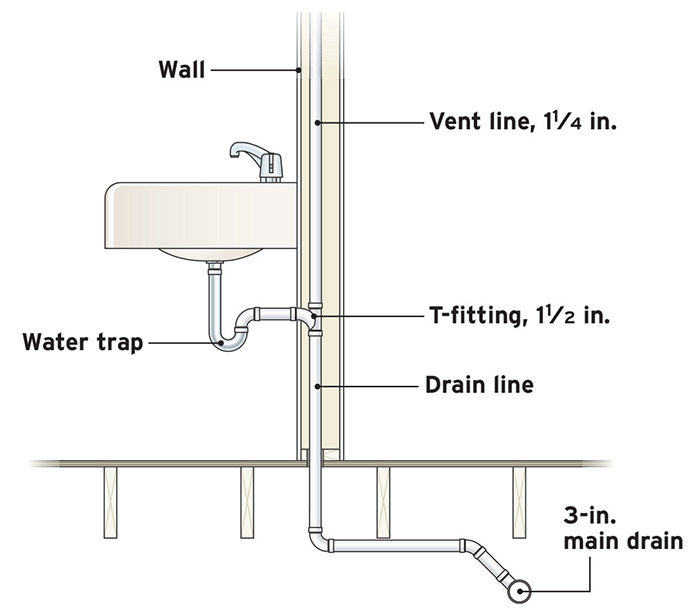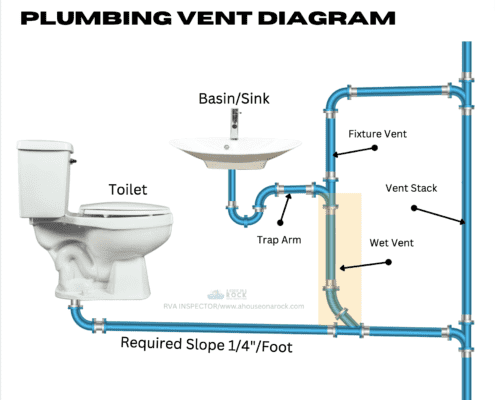The Benefits of Proper Ventilation in Your Plumbing System
The Benefits of Proper Ventilation in Your Plumbing System
Blog Article
In this article down the page you can locate some brilliant advice related to What Are Plumbing Vents and Why Are They Important?.

Correct air flow in plumbing systems is often forgotten, yet it is important for keeping the performance and safety and security of your home's plumbing. Ventilation assists manage air pressure, stop the buildup of damaging gases, and make certain the efficient removal of waste. In this guide, we will check out the value of proper plumbing ventilation, how it works, and the benefits it brings to your plumbing system.
How Ventilation Functions in Plumbing Solutions
Air Pressure Regulation
Proper air flow keeps well balanced air pressure within the plumbing system. When water moves via pipes, it displaces air. Without adequate air flow, this displacement can develop adverse stress, leading to reduce drains pipes or siphoning of water from catches, which can trigger unpleasant odors to permeate right into the home.
Protecting Against Sewer Gas Accumulation
One of the most critical functions of plumbing vents is to prevent sewer gases, such as methane and hydrogen sulfide, from accumulating within the home. These gases can pose serious wellness threats and are very flammable. Vent pipes allow these gases to run away securely outside.
Assisting in Waste Elimination
Ventilation assists in the reliable elimination of wastewater by avoiding airlocks in the water drainage system. When air can flow openly via the vents, it allows water and waste to flow smoothly through the pipes, minimizing the threat of obstructions and back-ups.
Advantages of Appropriate Ventilation
Enhanced System Performance
Correctly aerated pipes systems run a lot more efficiently, with less obstructions, faster draining pipes, and much less pressure on the pipelines. This effectiveness extends the life-span of the pipes system.
Improved Air High Quality
By preventing sewer gases from entering your home, appropriate air flow adds to far better interior air top quality, making your living environment healthier and more comfortable.
Preventing Water Damage
Sufficient ventilation helps avoid water from being siphoned out of traps, which can lead to sewage system gases getting in the home and triggering water damage over time.
Actions to Make Certain Appropriate Ventilation
Consulting Pipes Codes
Always speak with neighborhood pipes codes when designing or customizing your pipes system. These codes provide the required guidelines for proper venting and guarantee your system fulfills security criteria.
Routine Evaluation and Maintenance
Normal examinations can assist determine possible air flow problems before they become significant issues. Upkeep jobs, such as cleaning vent pipelines and looking for clogs, are vital for maintaining the system in good working order.
Specialist Installment
For brand-new installments or significant modifications, it's wise to hire a specialist plumbing professional. They have the expertise to ensure the air flow system is properly designed and mounted according to code.
Understanding Air Flow in Pipes
Ventilation in pipes refers to the network of pipelines that enable air to flow with the drainage system. These vents serve numerous functions, consisting of controling air pressure within the pipes, preventing drain gases from entering the home, and assisting in the smooth flow of wastewater.
Sorts Of Pipes Vents
Main Stack Vent
The major stack vent, additionally referred to as the air vent pile, is the key air vent in a pipes system. It extends from the main drain align via the roof, allowing gases to escape and fresh air to enter the system.
Branch Vent
Branch vents attach to the major pile vent and serve specific components, such as sinks, bathrooms, and showers. These vents ensure that each component has appropriate air flow to work correctly.
Air Admittance Shutoff (AAV).
An Air Admittance Shutoff (AAV) is a one-way valve that permits air to enter the plumbing system without the demand for a typical air vent pipe extending via the roofing. AAVs are frequently used in restorations or locations where installing a typical vent is impractical.
Indicators of Poor Ventilation in Plumbing.
Slow Draining Fixtures.
If your sinks, tubs, or bathrooms are draining pipes gradually, maybe an indicator of inadequate air flow. Poor air flow can develop a vacuum impact, making it difficult for water to drain effectively.
Gurgling Sounds.
Gurgling noises originating from drains are commonly a result of air being sucked with water catches as a result of adverse pressure in the pipes. This is a clear indicator of inadequate ventilation.
Undesirable Smells.
Drain smells inside your home are a warning that your plumbing system is not correctly ventilated. This can mean that sewer gases are not being sufficiently aired vent outside, causing possibly harmful conditions.
Typical Ventilation Mistakes.
Inadequate Vent Sizing.
Using undersized vent pipelines can lead to inadequate air flow and pressure imbalances in the system. It's necessary to make use of vents that satisfy the specific demands of your pipes system.
Improper Vent Placement.
Putting vents too much from the fixtures they offer can reduce their efficiency. Proper placement ensures that air can stream openly and efficiently via the system.
Disregarding Code Requirements.
Building ordinance offer certain standards for plumbing ventilation. Neglecting these codes can cause a system that falls short to function correctly and may result in expensive repair services or carcinogen.
Verdict.
Appropriate ventilation is an essential component of any type of plumbing system, making certain that it operates efficiently and safely. By understanding the significance of air flow, identifying the indications of bad air flow, and taking actions to preserve your system, you can stop expensive concerns and secure your home's air quality.
4 Things You Should Know About Your Plumbing Vents
What Plumbing Vents Are
Also called a vent stack, a plumbing vent is a vertical pipe attached to your drain line that runs through your roof. The plumbing vent pipe, or plumbing air vent, removes gas and odors from your plumbing system and allows fresh air to enter the pipes, helping the water to flow out of the drain pipes.
What Plumbing Vents Do
Plumbing vents have two basic functions. One of which is to allow unpleasant smelling wastewater and sewer gasses to escape your plumbing system instead of entering your home. Plumbing vent pipes are typically located on roofs, away from windows, to ensure the fumes exit the home completely.
The other function of the plumbing vent is to move fresh air into your plumbing system. This helps move water through every plumbing fixture in your house, like toilets and sink drains. Think of the way in which you need to let a little air into the bottle as you pour soda in order to make the drink flow smoothly.
Different Types of Plumbing Vents
True vent: This is the most common vent option. In simplest terms, a true vent is a vertical pipe attached to your drain line that exits through the roof. They often function as the main vent that other fixtures can connect to. Re-vent pipe or auxiliary vent: Attached to the drain line near specific plumbing fixtures, re-vent pipes run up and over to connect to the main vent. Common vent: Two plumbing fixtures installed on opposite sides of a wall are typically tied into the vent stack using something known as a sanitary cross. Wet vent: This venting option operates as a drain pipe and a vent at the same time. Wet vent drainage systems drain water from one fixture while venting the air from another. Although they’ve been used for over 100 years, wet vent systems have only recently been added to the plumbing code in many areas. If you’re planning on installing one in a bathroom remodel, make sure you check your local code prior to construction. Loop vent: For free-standing fixtures like kitchen island sinks, loop vents are ideal. These vent pipes run under the floor, rise from the P-trap, and create a loop inside the cabinet sink. Air admittance valve: An AAV is a one-way mechanical valve typically installed at the site of the plumbing fixture. AAVs allow venting to occur without having to tie into a larger venting system. They’re ideal for venting fixtures where you aren’t able to easily connect to an existing vent system. Common Plumbing Vent Issues
Although vent pipes typically don’t have water flowing through them, they’re still subject to many typical plumbing issues. For example, clogs are one of the most common problems associated with sewer vent pipes. If your vent pipe gets clogged, all of your plumbing fixtures tied into the vent stack will be affected.
A sink with a slow drain that bubbles and gurgles or a strong sewage smell around your toilet are both indicators that your toilet vent pipe is clogged. Because most vent pipes exit through the roof, old leaves, twigs or even a bird’s nest could be clogging the pipe.
Clogs in your vent pipe system cause a buildup of negative pressure, meaning that water won’t be able to flow out of your home very well. It’s similar to putting your finger over the opening of a straw to trap water inside. When you remove your finger, the water is able to flow out of the straw.
If you suspect you have any blockage in your vent, make sure you have a professional come examine the situation. Left unchecked, a blocked air vent can lead to other costly repairs, like leaks and sediment buildup.
Under Pressure
Pipe vents are essential aspects of a home’s plumbing system. Owning a home means learning about all sorts of things you never put much thought into before. But by understanding as much as you can about the important systems of your home, you can keep those budgets intact and those anxiety levels low.
https://www.homeserve.com/en-us/blog/home-improvement/plumbing-vents/

We were shown that report on through a pal on a different web address. Those who appreciated our page kindly do not forget to share it. I love reading our article about What Is a Plumbing Vent and Why Is It Important.
Book An Appointment Report this page